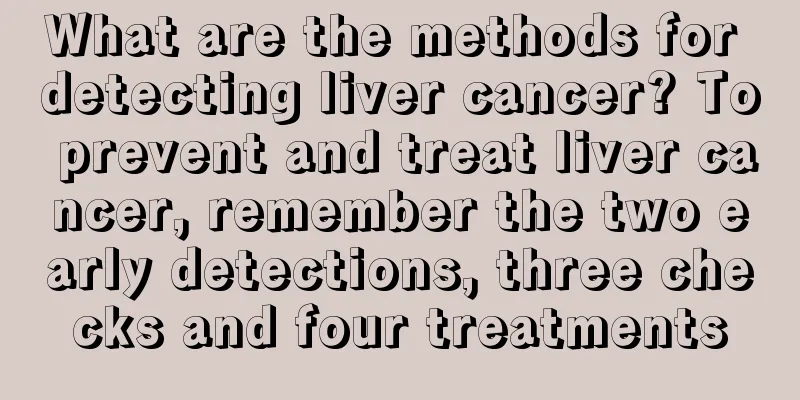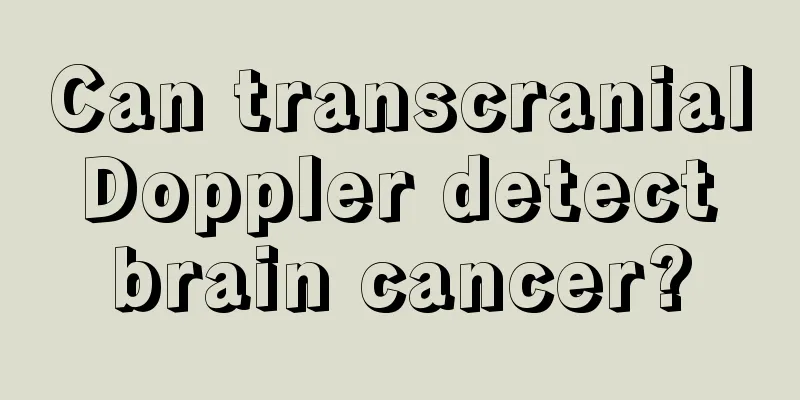What are the methods for detecting liver cancer? To prevent and treat liver cancer, remember the two early detections, three checks and four treatments

|
Highly accurate liver cancer detection gene Shanghai has developed a liver cancer detection gene (MXR7). By drawing 5 ml of blood from a person and screening it with the liver cancer detection gene, it is possible to confirm whether a person has liver cancer. Human liver cancer can be detected and correctly diagnosed early so that they can receive effective treatment in a timely manner. The commonly used method for liver cancer diagnosis is to detect alpha-fetoprotein in the blood, but there is a certain rate of missed diagnosis. This method of using gene detection plus imaging detection to diagnose early liver cancer can reach an accuracy rate of more than 80%, which is much higher than the detection rate of alpha-fetoprotein and is ahead of the international level. The liver cancer detection gene has obtained national and international patents. It is expected that in about 2 to 3 years, the liver cancer detection gene will be widely used in clinical practice. Other auxiliary examinations Liver function tests for liver cancer patients: help to understand the severity of liver damage and choose a reasonable treatment plan; assist in the diagnosis and differential diagnosis of liver cancer; predict whether it will recur after surgical resection, and judge the prognosis. Commonly used liver function tests in clinical practice mainly include bilirubin metabolism, protein metabolism, enzyme metabolism and dye excretion tests. Specific items include serum bilirubin, albumin/globulin, protein electrophoresis, alanine aminotransferase (ALT), γ-glutamyl transpeptidase (γ-GT), prothrombin time, etc. 1. Bilirubin Elevated serum bilirubin often indicates active liver disease, obstructive jaundice or advanced stage of the disease. Patients with total bilirubin>30?mol/L should not undergo surgery; those with total bilirubin>20?mol/L should be cautious when performing large liver cancer resection. 2. Absolute value of albumin/globulin The absolute value of albumin reflects the total number of effective hepatocytes, which is clearly exposed when the liver is chronically and severely damaged. The normal value of albumin is 35-55g/L, and major surgery is not suitable when the value is & 30g/L. The normal white/globulin ratio is 1.5-2.5. An inverted white/globulin ratio reflects liver decompensation and difficulty in tolerating major surgery. 3. Prothrombin time A significant prolongation of pT indicates severe liver damage and a poor prognosis. Surgery is not recommended when pT is 50% lower than normal. 4.γ-glutamate transpeptidase When the liver cancer is huge, there are extensive tumor thrombi in the portal vein, and liver function is abnormal, γ-GT will increase significantly, which will have a great impact on surgery or prognosis. 5. Alanine aminotransferase Abnormal ALT often reflects damage to liver parenchymal cells or massive necrosis of the tumor. ALT levels in tumor patients are significantly elevated, and the surgical mortality rate is also significantly increased. Liver cancer prevention and treatment: remember two early detections, three checks, and four treatments "Two early" improves efficacy: Two early prevention and treatment of liver cancer, mostly refers to early prevention and early diagnosis. Clinical practice has shown that the treatment effects of small liver cancers with a diameter of less than 3 cm and advanced liver cancers are completely different. Advanced liver cancers are often accompanied by intra- and extra-hepatic metastases, which cannot be surgically removed, and interventional embolization and drug treatments are difficult to be effective. However, for small liver cancers diagnosed in the early stages, surgical resection, embolization, ablation and other treatment methods are all effective. Early prevention is to avoid the spread of hepatitis, avoid liver damage caused by alcohol, drugs, etc., and prevent or alleviate the progression of liver fibrosis to the greatest extent. "Three checks": three-level census management, that is, conducting different checks according to three groups of people. According to the degree of liver cancer risk, people at high risk of liver cancer are generally divided into three categories. The first category is the high-risk group, such as patients who develop cirrhosis due to chronic viral hepatitis (hepatitis B or hepatitis C); the second category is the moderate-risk group, such as patients with chronic viral hepatitis but no family history of cirrhosis or liver cancer; the third category is the low-risk group, such as patients with cirrhosis due to non-viral reasons. The three-level census is to conduct different examinations according to the three groups of people. Generally, the high-risk group should undergo relevant examinations (liver function, alpha-fetoprotein and ultrasound) every three months; the moderate-risk group should undergo examinations at least once every six months; and the low-risk group should undergo relevant examinations once a year. When a suspicious case is found, CT, MRI or arterial angiography should be further performed until liver cancer is ruled out. "Four treatments": the four commonly used treatment measures for liver cancer. Surgical treatment is traumatic and expensive. In addition, liver lobectomy is affected by factors such as liver function, liver cancer location, and medical technology conditions. It is not an ideal choice for patients with cirrhosis. Local treatment, represented by radiofrequency, is less invasive, causes less damage to the liver, and can be used repeatedly. It has become the preferred treatment method for small liver cancer. The efficacy of interventional embolization therapy is restricted by the blood supply to the tumor artery, making it difficult to completely kill liver cancer cells, and it has no obvious therapeutic effect on the lesions in the liver tissue surrounding the cancer. Drug treatment includes chemotherapy, immunotherapy, traditional Chinese medicine, gene therapy, etc. Drug treatment is only an auxiliary to surgical treatment, and its efficacy is limited when used alone. |
>>: How is advanced liver cancer treated? Three clinical treatments for advanced liver cancer
Recommend
How to use the gourd powder puff
Powder puffs can be divided into many types. Depe...
This is how lumbar stenosis should be treated
Lumbar stenosis is a very common medical disease,...
What does metabolism mean
Metabolism is actually the general term for all o...
What should I do if my forehead is not full and sunken?
People care a lot about their appearance, because...
What is the function of licorice powder?
Licorice itself is a traditional Chinese medicina...
Does drinking vinegar on an empty stomach hurt your stomach?
Vinegar is a very common condiment in cooking, an...
Is cycling more likely to cause testicular cancer?
There is no direct scientific evidence to show a ...
When to stimulate ovulation in polycystic ovary
There are many patients with polycystic ovary in ...
How long can you live with mid-stage laryngeal cancer
It is not yet certain how long laryngeal cancer c...
How to avoid recurrence of testicular cancer
Suffering from testicular cancer is something tha...
What are the precautions after filling nasolabial folds
If the nasolabial folds are deep, it will affect ...
There are small itchy bumps on the side of my fingers
Because the weather is very hot and people's ...
Are succulents effective in protecting against radiation?
In fact, there are various anti-radiation methods...
The symptoms of colorectal cancer can develop from early stage to late stage
The symptoms of colorectal cancer can develop fro...
How to treat hand joint rheumatism
Everyone is familiar with rheumatism. Rheumatism ...









